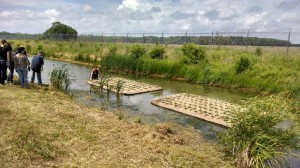Ocean Lakes High School, HRSD, and askHRgreen.org just teamed up to reduce stormwater pollution! You may be thinking, “but HRSD cleans the wastewater that leaves our homes, not the stormwater runoff from the streets”, and you’re right. When it rains, stormwater enters the storm drain system and flows directly into local waterways without being cleaned at a treatment plant. That’s why it is so important that we ALL do our part to reduce stormwater pollution! Like our neighborhoods, schools, and businesses, HRSD’s Atlantic Treatment Plant in Virginia Beach includes parking lots and other hard nonabsorbent surfaces. Rain can pick up all kinds of pollutants as it travels over these hard surfaces. At the plant, runoff washes into stormwater retention ponds, which ultimately flow into nearby Lake Tecumseh.
In order to reduce pollution entering the lake, Laura Wood’s Advanced Placement Environmental Science students from Ocean Lakes High School helped install two floating wetlands in one of HRSD’s stormwater retention ponds. Floating wetlands are man-made but mimic natural wetlands and are exactly what they sound like – islands of plants floating around in a pond. The plant roots grow through the “islands” and down to the water where they improve water quality by intercepting excess nutrients and trapping sediment and other pollutants. I know – so cool.
What’s even cooler? All of the plants for the islands were purchased with a mini-grant from askHRgreen.org. If you haven’t heard of the mini grant program, make sure to check out this great funding opportunity for teachers and other youth leaders. In May, the students planted the islands and launched them in the pond close to the site of stormwater influent. They worked hard and had a lot of fun doing it! HRSD scientists also showed the students how to collect water samples from the pond. Samples will continue to be collected and analyzed to monitor the impact of the floating wetlands on water quality.
But we are not the only ones who appreciate their effort…the students received a Green in Action Award from the Green Education Foundation for this project! Learn more about how your actions impact our waterways and join us in reducing stormwater pollution today.


